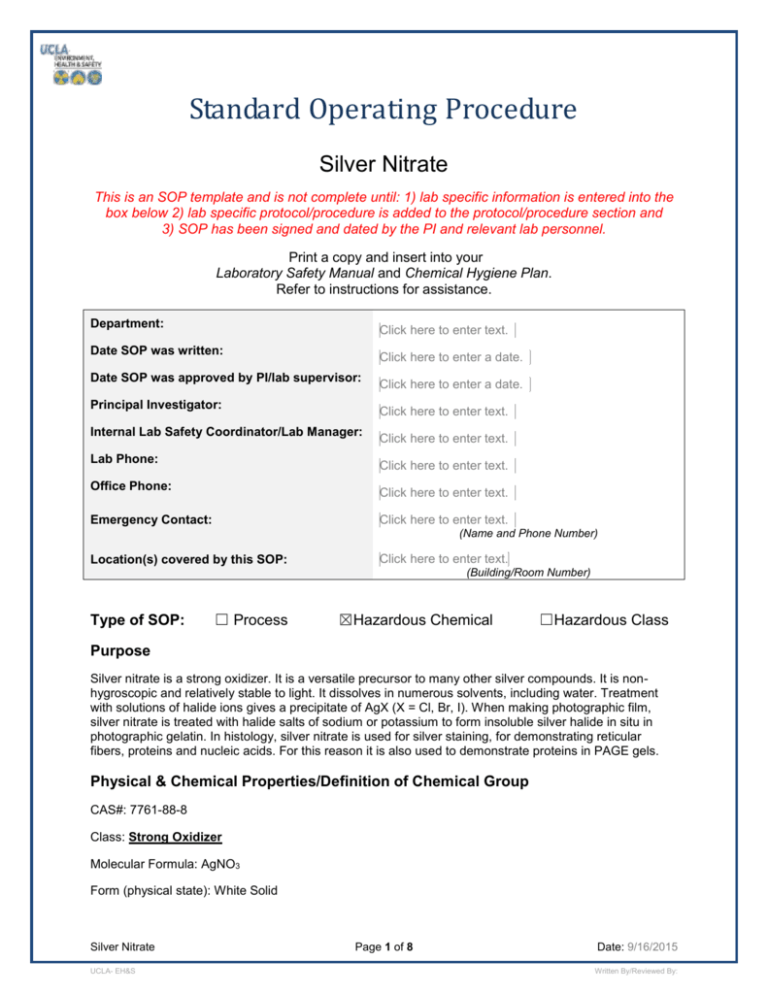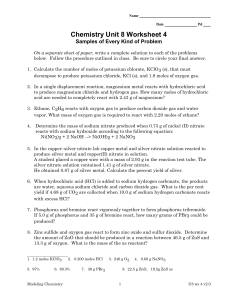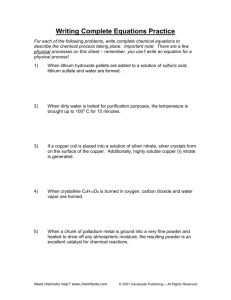Silver Nitrate Identifying Calcium
advertisement

Standard Operating Procedure Silver Nitrate This is an SOP template and is not complete until: 1) lab specific information is entered into the box below 2) lab specific protocol/procedure is added to the protocol/procedure section and 3) SOP has been signed and dated by the PI and relevant lab personnel. Print a copy and insert into your Laboratory Safety Manual and Chemical Hygiene Plan. Refer to instructions for assistance. Department: Click here to enter text. Date SOP was written: Click here to enter a date. Date SOP was approved by PI/lab supervisor: Principal Investigator: Click here to enter text. Internal Lab Safety Coordinator/Lab Manager: Lab Phone: Click here to enter a date. Click here to enter text. Click here to enter text. Office Phone: Click here to enter text. Emergency Contact: Click here to enter text. (Name and Phone Number) Location(s) covered by this SOP: Click here to enter text. (Building/Room Number) Type of SOP: ☐ Process ☒Hazardous Chemical ☐Hazardous Class Purpose Silver nitrate is a strong oxidizer. It is a versatile precursor to many other silver compounds. It is nonhygroscopic and relatively stable to light. It dissolves in numerous solvents, including water. Treatment with solutions of halide ions gives a precipitate of AgX (X = Cl, Br, I). When making photographic film, silver nitrate is treated with halide salts of sodium or potassium to form insoluble silver halide in situ in photographic gelatin. In histology, silver nitrate is used for silver staining, for demonstrating reticular fibers, proteins and nucleic acids. For this reason it is also used to demonstrate proteins in PAGE gels. Physical & Chemical Properties/Definition of Chemical Group CAS#: 7761-88-8 Class: Strong Oxidizer Molecular Formula: AgNO3 Form (physical state): White Solid Silver Nitrate UCLA- EH&S Page 1 of 8 Date: 9/16/2015 Written By/Reviewed By: Color: Click here to enter text. Boiling point: 444 °C, 831 °F Potential Hazards/Toxicity Strong oxidizer. Contact with other material may cause a fire. Causes burns by all exposure routes. Toxic to aquatic organisms, may cause long-term adverse effects in the aquatic environment. Target Organs: Eyes, skin, mucous membranes. Eye: Causes eye burns. Skin: Causes skin burns. May be harmful if absorbed through the skin. Ingestion: Causes gastrointestinal tract burns. May be harmful if swallowed. Ingestion of soluble silver salts may cause argyria, characterized by permanent blue-gray pigmentation of the skin, mucous membranes, and eyes. Lethal dose for humans is 2 grams, or about 28.6 mg/kg. Inhalation: Causes severe irritation of upper respiratory tract with coughing, burns, breathing difficulty, and possible coma. Chronic: May cause methemoglobinemia, which is characterized by chocolate-brown colored blood, headache, weakness, dizziness, breath shortness, cyanosis (bluish skin due to deficient oxygenation of blood), rapid heart rate, unconsciousness and possible death. Chronic inhalation or ingestion of silver salts may cause argyria characterized by a permanent blue-gray discoloration of the eyes, skin, mucous membranes, and internal organs. This malady results from the accumulation of silver in the body. Personal Protective Equipment (PPE) Respirator Protection Use this chemical in a chemical fume hood at all times. When a respirator is the sole means of protection, use a full-face supplied air respirator. Respirators should be used only under any of the following circumstances: As a last line of defense (i.e., after engineering and administrative controls have been exhausted). When Permissible Exposure Limit (PEL) has exceeded or when there is a possibility that PEL will be exceeded. Regulations require the use of a respirator. An employer requires the use of a respirator. There is potential for harmful exposure due to an atmospheric contaminant (in the absence of PEL) As PPE in the event of a chemical spill clean-up process Lab personnel intending to use/wear a respirator mask must be trained and fit-tested by EH&S. This is a regulatory requirement. (https://www.ehs.ucla.edu/ep/ih/resp) Hand Protection Neoprene, nitrile or butyl rubber gloves are recommended. Consult with your preferred glove manufacturer to ensure that the gloves you plan on using are compatible with Silver Nitrate. NOTE: Consult with your preferred glove manufacturer to ensure that the gloves you plan on using are compatible with Silver Nitrate. Refer to glove selection chart from the links below: http://www.ansellpro.com/download/Ansell_8thEditionChemicalResistanceGuide.pdf Silver Nitrate UCLA- EH&S Page 2 of 8 Date: 9/16/2015 Written By/Reviewed By: OR http://www.allsafetyproducts.com/glove-selection-chart-chemical-breakthrough-ratings.html OR http://www.showabestglove.com/site/default.aspx OR http://www.mapaglove.com/ Eye Protection Type of eye protection used to handle the chemical: Splash goggles. If used in large quantities, please use appropriate face shield. Skin and Body Protection Lab coats should be worn. These laboratory coats must be appropriately sized for the individual and be buttoned to their full length. Laboratory coat sleeves must be of a sufficient length to prevent skin exposure while wearing gloves. Full length pants and close-toed shoes must be worn at all times by all individuals that are occupying the laboratory area. The area of skin between the shoe and ankle should not be exposed. Hygiene Measures Avoid contact with skin, eyes and clothing. Wash hands before breaks and immediately after handling silver nitrate solutions or solid. Engineering Controls Work with this chemical in a certified ducted fume hood. Facilities storing or utilizing this material should be equipped with an eyewash facility and a safety shower. First Aid Procedures General advice Consult a physician. Show this safety data sheet to the doctor in attendance. Move out of dangerous area. If inhaled Remove from exposure and move to fresh air immediately. If breathing is difficult, give oxygen. Get medical aid. Do not use mouth-to-mouth resuscitation if victim ingested or inhaled the substance; induce artificial respiration with the aid of a pocket mask equipped with a one-way valve or other proper respiratory medical device. In case of skin contact Get medical aid. Immediately flush skin with plenty of water for at least 15 minutes while removing contaminated clothing and shoes. In case of eye contact Immediately flush eyes with plenty of water for at least 15 minutes, occasionally lifting the upper and lower eyelids. Get medical aid. If swallowed Get medical aid immediately. Do NOT induce vomiting. If conscious and alert, rinse mouth and drink 2-4 cupfuls of milk or water. Notes to Physician: Treat symptomatically and supportively. Special Handling and Storage Requirements Handling: Wash thoroughly after handling. Remove contaminated clothing and wash before reuse. Minimize dust generation and accumulation. Do not get in eyes, on skin, or on clothing. Do not ingest or Silver Nitrate UCLA- EH&S Page 3 of 8 Date: 9/16/2015 Written By/Reviewed By: inhale. Use with adequate ventilation. Keep from contact with clothing and other combustible materials. Inform laundry personnel of contaminant's hazards. Precautions for safe handling Avoid contact with skin and eyes. Avoid inhalation of particles. Always use inside a chemical fume hood. Conditions for safe storage Do not store near combustible materials. Keep container closed when not in use. Store in a cool, dry, well-ventilated area away from incompatible substances. Store protected from light. Avoid storage on wood floors. Spill and Accident Procedure Spills/Leaks: Vacuum or sweep up material and place into a suitable disposal container. Avoid generating dusty conditions. Provide ventilation. Keep combustibles (wood, paper, oil, etc.,) away from spilled material. Personal precautions Use Personal Protective Equipment (PPE). Avoid breathing vapors, mist or gas. Ensure adequate ventilation. Environmental precautions Do not let product enter drains. NOTE: Always have a chemical spill kit fully stocked and easily accessible at all times. Chemical Spill Dial 911 and x59797 Spill – Assess the extent of danger. Help contaminated or injured persons. Evacuate the spill area. Avoid breathing vapors. If possible, confine the spill to a small area using a spill kit or absorbent material. Keep others from entering contaminated area (e.g., use caution tape, barriers, etc.). Small (<1 L) – If you have training, you may assist in the clean-up effort. Use appropriate personal protective equipment and clean-up material for chemical spilled. Double bag spill waste in clear plastic bags, label and take to the next chemical waste pick-up. Large (>1 L) – Dial 911 (or 310-825-1491 from cell phone) and EH&S at x59797 for assistance. Chemical Spill on Body or Clothes – Remove clothing and rinse body thoroughly in emergency shower for at least 15 minutes. Seek medical attention. Notify supervisor and EH&S at x59797 immediately. Chemical Splash Into Eyes – Immediately rinse eyeball and inner surface of eyelid with water from the emergency eyewash station for 15 minutes by forcibly holding the eye open. Seek medical attention. Notify supervisor and EH&S at x59797 immediately. Medical Emergency Dial 911 or x52111 Life Threatening Emergency, After Hours, Weekends And Holidays – Dial 911 (or 310-825-1491 from cell phone) or contact the Ronald Reagan UCLA Medical Center (emergency room) directly at x52111 Silver Nitrate UCLA- EH&S Page 4 of 8 Date: 9/16/2015 Written By/Reviewed By: (located at 757 Westwood Plaza, enter from Gayley Avenue). Note: All serious injuries must be reported to EH&S at x59797 within 8 hours. Non-Life Threatening Emergency – Go to the Occupational Health Facility (OHF), x56771, CHS room 67-120 (This is on the 6th floor, 7th corridor, room 120. Enter through the School of Dentistry on Tiverton Drive and proceed to the “O” elevator to the 6th floor.)Hours: M - F, 7:30 a.m. to 4:30 p.m. At all other times report to Ronald Regan UCLA Medical Center (emergency room) at x52111. Note: All serious injuries must be reported to EH&S at x59797 within 8 hours. Needle stick/puncture exposure (as applicable to chemical handling procedure) – Wash the affected area with antiseptic soap and warm water for 15 minutes. For mucous membrane exposure, flush the affected area for 15 minutes using an eyewash station. Page the needle stick nurse by dialing 231 from a campus phone, enter 93333 when prompted and then enter your extension. Hours: M – F, 8:00 a.m. to 4:00 p.m. At all other times report to Ronald Regan UCLA Medical Center (emergency room) at x52111. Note: All needle stick/puncture exposures must be reported to EH&S at x59797 within 8 hours. Decontamination/Waste Disposal Procedure Wearing proper PPE, please decontaminate equipment and bench tops using soap and water. Please dispose of aqueous silver nitrate solutions as hazardous waste. General hazardous waste disposal guidelines: Label Waste Affix an on-line hazardous waste tag on all waste containers using the WASTe Online Tag Program https://ehs.ucop.edu/waste as soon as the first drop of waste is added to the container Store Waste Store hazardous waste in closed containers, in secondary containment and in a designated location Double-bag dry waste using transparent bags https://www.ehs.ucla.edu/hazwaste/management/containers Waste must be under the control of the person generating & disposing of it Dispose of Waste Dispose of regularly generated chemical waste within 90 days Call EH&S at x61887 for questions Empty Containers o Dispose as hazardous waste if it once held extremely hazardous waste (irrespective of the container size) https://www.ehs.ucla.edu/hazwaste/types/extremely-hazardous o Consult waste pick-up schedule https://www.ehs.ucla.edu/hazwaste/management/pick-ups Prepare for transport to pick-up location Check on-line waste tag Write date of pick-up on the waste tag Use secondary containment Safety Data Sheet (SDS) Location Online SDS can be accessed at http://msds.ehs.ucla.edu. Protocol/Procedure Amount Covered 0-25 g – to prepare stock solution 0-100 ml 1% silver nitration solution – to identify calcium Silver Nitrate UCLA- EH&S Page 5 of 8 Date: 9/16/2015 Written By/Reviewed By: Temperature Covered 2°C - 26°C Silver nitrate is most commonly used for silver staining. Silver nitrate is hazardous when inhaled and especially when it comes into contact with skin and mucous membranes. Always wear appropriate PPE and work with silver nitrate in a fume hood. Protocol for Identifying Calcium Description: This technique is for demonstrating deposits of calcium or calcium salt so it is not specific for the calcium ion itself. In this method, tissue sections are treated with a silver nitrate solution and the silver is deposited by replacing the calcium reduced by the strong light, and thereby visualized as metallic silver. Fixation: formalin fixed, paraffin embedded tissue sections or alcohol fixed, frozen sections. Solutions and Reagents: 1% Aqueous Silver Nitrate Solution: Silver nitrate: 1 g from a 25 g stock bottle Distilled water: 100 ml 5% Sodium Thiosulfate: Sodium thiosulfate: 5 g Distilled water: 100 ml 0.1% Nuclear Fast Red Solution: Nuclear fast red: 0.1 g Aluminum sulfate: 5 g Distilled water: 100 ml Dissolve aluminum sulfate in water. Add nuclear fast red and slowly heat to boil and cool. Filter and add a grain of thymol as a preservative. Protocol: 1. Deparaffinize paraffin sections and hydrate to water. 2. Rinse in several changes of distilled water. 3. Incubate sections with 1% silver nitrate solution in a clear glass coplin jar placed under ultraviolet light for 20 minutes (or in front of a 60-100 watt light bulb for 1 hour or longer). Note: If stain was weak or rinsed off in washing steps, it indicated the UV light was not strong enough. Longer staining is required for up to several hours. 4. Rinse in several changes of distilled water. 5. Remove un-reacted silver with 5% sodium thiosulfate for 5 minutes. 6. Rinse in distilled water. 7. Counterstain with nuclear fast red for 5 minutes. 8. Rinse in distilled water. 9. Dehydrate through graded alcohol and clear in xylene. 10. Coverslip using permanent mounting medium. NOTE Any deviation from this SOP requires approval from PI. Documentation of Training (signature of all users is required) Lab personnel working with Silver Nitrate must have attended the ‘Lab Safety Fundamental Concepts’ (LSFC) classroom training offered by EH&S. Please refer to the link below for training schedule and enrollment information: http://map.ais.ucla.edu/go/1003938#Laboratory_Safety Silver Nitrate UCLA- EH&S Page 6 of 8 Date: 9/16/2015 Written By/Reviewed By: To work with Silver Nitrate, the lab personnel must have had hands-on training provided by the lab PI/Supervisor. This training must be documented in the form of a log sheet with name of the trainer, name of the trainee, UID, date of training and signature of both trainer & trainee. Prior to conducting any work with Silver Nitrate, designated personnel must provide training to his/her laboratory personnel specific to the hazards involved in working with this substance, work area decontamination, and emergency procedures. The Principal Investigator must provide his/her laboratory personnel with a copy of this SOP and a copy of the SDS provided by the manufacturer. The Principal Investigator must ensure that his/her laboratory personnel have attended appropriate laboratory safety training or refresher training within the last one year. Principal Investigator SOP Approval Print name __________________________Signature___________________________ Approval Date: I have read and understand the content of this SOP: Name Signature Date Click here to enter text. Click here to enter a date. Click here to enter text. Click here to enter a date. Click here to enter text. Click here to enter a date. Click here to enter text. Click here to enter a date. Click here to enter text. Click here to enter a date. Click here to enter a date. Click here to enter text. Click here to enter text. Click here to enter a date. Click here to enter text. Click here to enter a date. Click here to enter text. Click here to enter a date. Click here to enter text. Click here to enter a date. Click here to enter a date. Click here to enter text. Silver Nitrate UCLA- EH&S Page 7 of 8 Date: 9/16/2015 Written By/Reviewed By: Click here to enter text. Click here to enter a date. Click here to enter text. Click here to enter a date. Silver Nitrate UCLA- EH&S Page 8 of 8 Date: 9/16/2015 Written By/Reviewed By:





